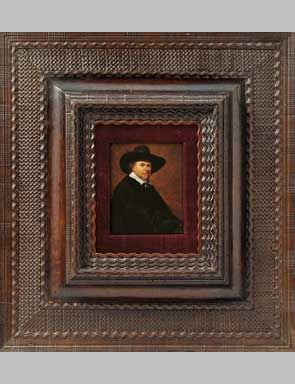'Structure and Ornament' @ The Lichtenstein Museum
Gerard Ter Borch (1617–1681), Portrait of the Painter Jan van Goyen, 1652, Oil on wood panel, 19,4 x 15.7 cm. Inscribed at bottom right: CB. © Sammlungen des Fürsten von und zu Liechtenstein, Vaduz–Wien.
VIENNA.-From 15 May 2009 to 12 January 2010 the LIECHTENSTEIN MUSEUM will be staging the exhibition STRUCTURE AND ORNAMENT which presents a cross-section of the history and typology of the frame from the late medieval period to the 19th century. It will also showcase the various different techniques involved, from construction to finishing, gilding and patination. Around 100 objects from the Collections’ holdings will be complemented by works from important private collections in Britain, France and Germany as well as by major loans from national and international museums.
What awaits the visitor are original frames from the Princely Collections, many never before displayed in public and including a number of spectacular individual pieces: a monumental tondo from the 15th century, a Baroque mirror frame of Roman provenance and gigantic dimensions, a picture frame made to a design by Gian Lorenzo Bernini, a richly inlaid ivory frame by Massimo Soldani-Benzi as well as companion pieces from Austria of equal artistic importance.
The exhibition illustrates the phenomenon of the frame in context with furniture, metalwork and textiles as well as graphics and engravings of ornamental motifs together with miniature paintings in precious settings. Some of the gilded or painted frames are being exhibited with the paintings for which they were created, and the exhibition is rounded off by bronze or terracotta reliefs in their original frames.
The exhibition focuses not only on the theme of the paintings contained by frames of this kind but also on the intriguing subject of their use within the context of how galleries were hung in the past and their continued relevance in modern-day museum presentation. In 1705 Giovanni Giuliani was commissioned by Prince Johann Adam Andreas I von Liechtenstein to create the frames for the Decius Mus cycle by Peter Paul Rubens with their powerful, elaborately carved and gilded crests. At Feldsberg, the central residence of the Liechtenstein family in southern Moravia, papier mâché frames were made and painted in colours or gilded, evidently with the aim of displaying the holdings of the picture gallery there in a manner as impressive (and no doubt economical) as possible.
For the re-hanging of the gallery in the family’s former summer palace in the Rossau quarter, Prince Johann I von Liechtenstein commissioned new frames in Neoclassical taste for almost all the paintings displayed there; today many of the frames in the LIECHTENSTEIN MUSEUM still proudly bear his ligated monogram JL. Even tapestries were framed like paintings in order to make them an integral part of the wall décor.
The LIECHTENSTEIN MUSEUM today invests much effort and expense not only in the acquisition of new works but also in their presentation, one of the most important aspects of which is their frames. Over the past few years important examples of Renaissance and Baroque frames, including those mentioned above by Gian Lorenzo Bernini and Massimo Soldani-Benzi, have been added to the holdings of the Princely Collections.
HISTORICAL REVIEW
Frames can be found with Roman mural paintings that disclose views of imaginary landscapes, and with the beginnings of Western panel painting they were often integrated into the picture itself. In the Renaissance frames rose to prominence in their own right and contributed significantly to the individualisation of the picture, which from this time on presents itself increasingly as an autonomous work of art.
A wholly different perspective arose during the Baroque with the idea of the picture gallery, whereby the individual paintings – separated only by slender battens – were organised on principles of size and symmetry to cover entire walls. Towards the end of the 18th century, collectors began again to respect the individuality of each work by commissioning uniform gallery frames for their paintings. Later developments attempted to go one step further, placing paintings in frames that corresponded to the period of their origin. During the period of Historicism, this goal was achieved in particular with copies of historical models.
The “revolutions” of the 20th century also affected frames, and the re-hanging of important galleries in the 1950s and 1960s (Florence, Uffizi; Verona, Castellvecchio –1959–1973) by Carlo Scarpa, who condemned all frames, displaying pictures bare of any framing – altarpieces dismantled into individual images and canvases supported merely by their stretchers – had a great, albeit misleading, influence on smaller provincial galleries.
The later consequence of this led to a renewed appreciation of the value of historical frames, especially in the English-speaking world, which had remained virtually untouched by continental European Modernism. Since its reopening in 2004, the LIECHTENSTEIN MUSEUM has followed this revival, attaching the highest importance to the framing of its paintings: the framing and display of a work enhances its effect and intention, thus facilitating its reception by the onlooker.

/https%3A%2F%2Fprofilepics.canalblog.com%2Fprofilepics%2F1%2F0%2F100183.jpg)



/http%3A%2F%2Fp9.storage.canalblog.com%2F92%2F51%2F119589%2F98216442.jpg)
/https%3A%2F%2Fassets.over-blog.com%2Ft%2Fcedistic%2Fcamera.png)
/https%3A%2F%2Fstorage.canalblog.com%2F77%2F60%2F577050%2F66527770_o.jpg)
/https%3A%2F%2Fstorage.canalblog.com%2F91%2F69%2F577050%2F66524735_o.jpg)